It is now, amazingly, 3 years since I started Feeding Edge ltd. Three years out of the relative cozy confines of corporate life. Note: That’s cozy in the sense that there is a structure, I am not suggesting anyone has it easy there. I spent 20 years in mainstream employment at IBM and I have now spent a fair amount of time acclimatizing and adjusting to a lack of structure. Oddly it was that structure and it’s positives and negatives that powers a degree of invention and skunkworks with many of the more sparky people in the company (or any company). Out in the rest of the world there are different combinations of structures there to work around, to adjust and flow with. They are just not always so obvious.

What has not changed is my attitude to helping people and to the technology, and just doing the right thing because it needs doing. If anything this has grown with a bit more freedom to explore and express ideas.
I do still suffer from the diversity of things that I get into with Feeding Edge. I was asked at a conference yesterday, after I presented, what I do with Feeding Edge. It is still the case that with this vessel I am “Taking a bite out of technology so you don’t have to”.
Most of my practical technical architecture, design, coding, presenting, funds raising, inventing etc is going towards an ever growing game related project as part of another startup. The ideas within that I still find amazing in their reach into social media and games and really it just needs a few more people focussed on the specifics of all the bits I ended up inventing. Which comes back to ongoing funding and buy-in to the project. So in many ways that is the same as many projects people have in corporate life, looking for backers, support etc.
It is reassuring to see things like Double Fine’s $2million raising of funding with crowdfunding on Kickstarter waking up a few business people and government departments this side of the pond. (Crowdfunding appears to be on a strange legal footing over here in the UK)
Another major strand for me this past year has of course been the Cool Stuff Collective TV show. Presenting, and working on creating the pieces with Archie Productions for CITV/ITV has given me a strand of content to take and talk about in all sorts of places. I have been very proud of the content and of the subjects we covered for kids and I now use those threads to try and inspire more kids in to tech at other events and conferences, whilst at the same time relaying the story of how we make that to adults. This also time informs them of some of the tech they may not have been aware of, but not in a head on way as it is about kids and a TV show.
So the question is how does this all move forward? Another year ahead.
I do occasionally look at job adverts, knowing pretty much that any job I took could get incredibly enthused with and maybe make a little bit of a difference. Not just tech ones either as I have developed a lot over the years in working with people, persuading, leading, mentoring and educating. All the technologies I share and talk about are about people and also about huge economic and social changes to come. Tech jobs are usually know version x or y, but there is so much more to be done.
I have yet to see a role that fits all the things I do with Feeding Edge, which makes me think either I have some sort of Unique Selling Point in diversity, or I should forget being a polymath and just focus on one thing.
It is not the case that I have no plan, but my plan is to carry on doing whatever it is I do. It really does not matter that it is hard to clarify and comparmentalize, because I am out in a world of infinite opportunity. Trying lots of things, threading many of those things together so they support one another, building tech, talking tech, living tech makes it much easier than being one particular thing or one particular role.
Of course all this comes at a cost. This approach, like starting brand new career strands such as TV presenting are back in the first rung of the ladder. That ladder being reputation, financial, etc. Stopping at any point, not doing a speaking engagement for instance, quickly erodes any building and levelling up that I may be doing in a particular industry, making new contacts etc. Conferences seldom pay directly, but the conversations lead to other things. The same as Tweeting and blogging are a “free” activity where you have to keep going, keep sharing to generate enough of a gravity well for someone to want to engage. “How do you find time to ….” well you just have to do it and weave it into life.
I often reflect as I hurtle from event to event that it is like being a touring rock band before the huge record deal. You play everywhere and anywhere that people will listen. Writing those killer tunes, practising the art. Which in the end is the most important thing. Though you dream of a stadium gig and a number one single.
So in the ups and downs of finance I have to say a huge thank you to my wife Jan (@elemming). She left IBM too, but only a few weeks ago and took up a fantastic opportunity based in London. It took a lot to leave after an even longer time than I spent there. It was worth it for the change and the impact she is able to have. Wherever you work you will start to be taken for granted eventually however good you are.
If you are reading this and think, we should get him in to talk to us, please do 🙂 If you are reading this and thinking there is nothing we need him to tell us and show us, well! you are exactly the sort of people that REALLY need me to come and help you.
See how that works? I do make life complicated for myself don’t I 🙂
Also please take a look at the new TV showreel 🙂 if you haven’t already.
future
Hacking up north to the future
This Saturday there is a large gathering of various technorati who are passionate about making sure the next generation gets to understand and see what a wonderful science filled world they have the ability to shape. We have been gathered mostly by social media and twitter in the first place by Alan Teknoteacher O’Donohoe
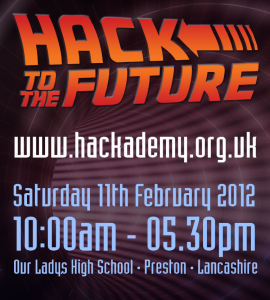
It is Hack To The Future, an unconference style event being held in Preston. Andy piper,recently liberated from the old firm and I are driving up today ready for an early start on Saturday.
You can tell that we are all keen as for us Preston is a 260 mile drive up into that north west of England. Quite a trek. There are people coming from equally far a field.
I will hopefully being inspiring the attendees and fellow presenters with tales from Cool Stuff Collective and my blurring of physical and virtual worlds. As we have all agreed to just go with the flow though this may, as with any unconference, turn into something completely different. There is a wiki explaining some of the sessions, but the on the day this gets finalised
I am sure we will all blog and report on proceedings too, assuming we don’t get snowed in!
More Digital/Physical blurring experiences – Choi Kwang Do
Back in June last year I started using my Xbox and Kinect sensor with physical fitness in mind. So to all intents and purposes I was playing a game, as the blurb says, with my body as a controller. This was the UFC Trainer. UFC is a mixed martial arts championship that has spun off a lot of franchise activity. It started as cage fighting, pitting extremely well trained and tough fighters in various styles against one another. Nothing virtual about that. However, as with many things it has spawned traditional fighting AAA games titles. Which is a fairly normal path. What is more exciting though has been the move to create the personal trainer that you interact with by actually performing the exercises. This is not really a game, it is a rep counter and technique tutorial.
Standing in front of the kinect the system will ask you to start throwing hooks or crosses, knee kicks etc. It looks very roughly at your form and counts and shouts at you to meet the rep target. It is not all fighting though, traditional push ups and dumbbell exercises, squats, lunges and holds. To avoid the boredom you may get from a video/DVD style exercise this is of course able to be a bit more dynamic. 30,60 and 90 day programmes in weight loss, endurance or strength provide a ramping up of lots of different styles of workout that are also adjusted by your fitness level. This turns out to be a doubling of reps as you step up in the fitness test it gives you, but it feels much more varied.
So whilst this is a “game” on a “game console” and isn’t real contact fighting it is a very rigorous workout and with the graphs and stats it tracks for you it feels very comprehensive. The effects on your body are very real especially after a few months sticking with it.
The other thing it has built-in is sharing with social media, however it never worked very well as the website, like many game websites is pretty appalling, looping registrations, lots of region specific switching etc. So I let Raptr fill in my activity on Facebook.
So this game to physical activity started to feel part of life and my youngest (predlet 2.0) started to ask about having a go with the kinect to do exercises. I felt he was a little too young to do this on his own and that we would be better in a real martial arts class, with his peers and an attentive instructor. Doing any exercise, developing bad form and habits can do lots of damage!
Then, serendipity kicked in, a leaflet appeared at school for the fastest growing martial art in the world the Korean inspired Choi Kwang Do, and a new school opening around the corner.
I didn’t know much about it but it clearly was aimed at both adults and kids to do physical training in a practical sense but without the direct competition of combat. Still lots of hands on kicks and punches though.
So we went along to out trial lessons with SouthcoastCKD and I was immediately taken by the style and the ethos. Predlet 2.0 seemed to like it too. Being abel to train together at a family session and also I get to go to adult sessions as and when I can makes this ideal.
I had wanted to do a martial art since I was about Predlet 2.0’s age but had never actually taken the plunge. Now, the xbox training since June in mixed martial arts and general flexibility and fitness has inspired me to level up to a real class.
Of course this is a nice circular story in that now when I train on UFC kinect and will start to adjust the style to that of CKD, as none of the strikes are lock out punches. The Xbox will not really worry as it does not try and get precise form, only counts the general action.
That’s the thing with video games they rot your brain and make you lazy!</sarcasm>
People used to shun games now they ‘tion them
This title People used to shun games now they ‘tion them is something I tweeted to @TheKevinDent when he was riffing on the use of games being referred to as gamification by adding fication to common task was doing. I was joining in identifying that there is a rush towards games being acceptable, yet at the same time treated as a bandwagon. For some people the very idea that you can just slap a game in the process will solve their inadequacies of product, sales, management, HR policy etc continues to put games down as somehow an add on and not a integral part of life. The same happens with technology, anyone who is a techie will know how ever expert they get, however they diversify at some point they will be handed a broken phone or laptop by someone not skilled in the art and asked to fix it to prove themselves. Very few other professions (with the exception of being a comedian) are you asked to perform some party trick to prove you know what you are doing in this way. You don’t sit at a table with a banker and say oh go on just bank will you.
The commodity of games is being asked in some inappropriate places to “go on tell us a joke and make us laugh”. However, I am not totally against gamification as is does herald a moving on in understanding of something that was very much a quirky area for those of us who were early adopters.

This year is the 30th anniversary of the Commodore 64, I still have mine as you can see above. The Independent had a good article on Flight of the Commodore: How the iconic computer led to a golden age of geeks and to see things like attack of the mutant camels getting a mention once again certainly took me back to a magical time. Don’t get me wrong loading from a tape deck was a right pain, the games were simple yet elegant, but we did have that direct connection with the environment to be able to make new things. This, and the zx81 I had before shaped who I was to become and how my career, however bizarre, has evolved. Hence great fondness, and also a willingness to let another generation grow and learn from that.
There are some elements to what you might call gamification, that diverge from just adding badges to things. (I still maintain business is a game anyway, people use piles of money and positions on the corporate ladder to measure success or failure).
In many of my talks now I end up in this sort of territory and seems to boil down to the fact that games are not just an end product of a manufacturing process. In the c64 days people wrote games, we loaded them and played them, or we wrote our own. There was not the capacity to use an existing game as a platform for something else.
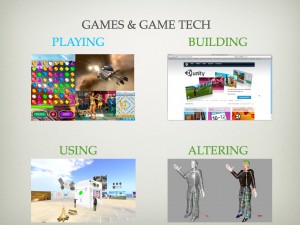
Playing games was the thing that people shunned. Play being regarded as a frivolous lack of work. That of course can still be the case but we know with the advances in the sort of games that exists that playing and rehearsing, experiencing things virtually all add to our human experience.
For the more serious minded, building games. It is strange that many computer scientists and software engineers still think that because the end product is colourful and things moves and lights flash that the level of engineering in games is not worthy. That is of course utter tosh. It is totally driven by the view of an end user and not liking the end product for whatever reason, usually few of exhibiting sub standard performance in front of someone skilled in the game. It is the path of building games that let us excite the next generation of software engineers. Kids play games and they DONT think they are a wast of time and pointless. i.e. they are the same as we were in the 80’s on our c64, “wow that’s cool I wish I could do that”
Luckily the world has also evolved to allow us to not just be either a player of a game or a builder of a game. Tools, games styles, application of game technology have provided all sorts of toolkits in games that let anyone create things, share things and make things happen. Some of these are just simple customisations, the sort that lend themselves to brand involvement (let me were my Nike tshirt in the game). Others are expressions of deeper creativity, painting cars in Forza4. There are even the much deeper technical challenges, building complex logic machines in Little Big Planet to create game levels. It is these elements that really look like the future of games in places where games would not normally tread, probably more so than badges and loyalty points. It is about deep engagement with ideas, brands, people etc across multiple places and platforms including the physical world. It is also very much about people being able to adjust build and mash together as they see fit.
It is Maker Culture
So it is good that the future for games is good, it is woven into society and will help us level up our kids if we think about it and use them wisely. (Oh and still enjoy a good frivolous play aswell!)
Join in NOW on government future of ICT plans
There is currently a government consultation on the future of ICT open to all to comment on. It is here. There is an online form to fill in with just 4 pages.
Any of you concerned with the future of computer science and technology education in the UK really should just fill this in firstly as an individual, but also try to get official responses from your organisations and employers.
All the comments do add to the weight of concern we all have.
My response was mainly that this is about people being able to show how the technology works, using easily accessible resources, not about a huge IT spending requirement. It is the passion of the tech industry, maker culture and experiences professionals that will make the difference. Eventually that will mean more technology and science related teaching.
It turned out I was response number 22 so I seem to have got in early. I would be interested to see what the numbers are like as this is something almost everyone I know in the tech and games industry feels very strongly about. So lets try and add to the weight of the argument with some positive suggestions to the government.
(The BCS is heavily involved hence us doing it as individuals as well, just mention you are BCS or IET, STEMnet Advisor etc in the form)
I will be running for office before you know it 🙂
This year will be printed – 2012 fabricaneur
My journey deeper into the RepRap 3d printers is continuing at a pace. This is good as it is about 14 years since I “quite fancied getting one” but didn’t have a spare £200,000 and the company I worked for couldn’t quite see the point, which at the time was fair enough.
It was in 2006 when I nearly spent a few thousand on one, but bought Second Life islands instead.
Now it is all merging, as predicted. The 3d design of virtual worlds and the tools around those provide a great distribution mechanism for content to be printed. It’s not all completely straightforward but in this Maker Culture we only need a few bits that hook together to put a workable solution in place for most things.
After doing the 3d printing piece on Cool Stuff Collective I said to Malcolm Napier I was up for joining in his Thames Valley RepRap User Group (TVRRUG) as they were gathering a group of people to mass buy and tweak the RepRap Prusa model. The cost of this being well below any other way of doing this, in the hundreds. Whilst its a bit of a trek to go to the meetings (part of this is about socialising the tech) there are plenty of online ways to share. That of course is the point and where being a metaverse evangelist fits in.
I picked up the first parts of the kit from Malcolm last Friday. Then spent a few nights with spanners, youtube and a hammer putting together the first part of the kit. I am primarily a software person, mechanical engineering has never been my strong point, though electronics, soldering etc is or was. So I figured that if I applied myself and got the right tools, with the support of TVRRUG I would be able to make this work.
So it started as a cardboard box of bits. The main structural pieces are metal rods, joints, angles and moving parts have been printed on a reprap (which is the point of the design to self replicate)
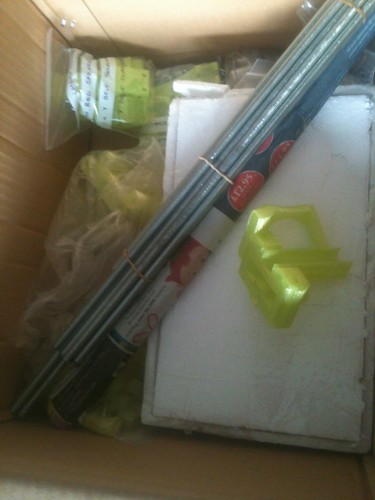
Its gives you a bit of a oh heck where do I start moment as you unbox.
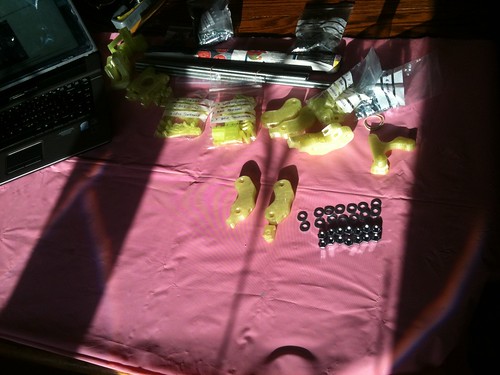
However, the prusa video explanations get you going very quickly. The fixed camera position and clear audio really helps. There is text to read and fall back to but I found the audio and visual worked just fine.
Once the first parts went together…. we were away
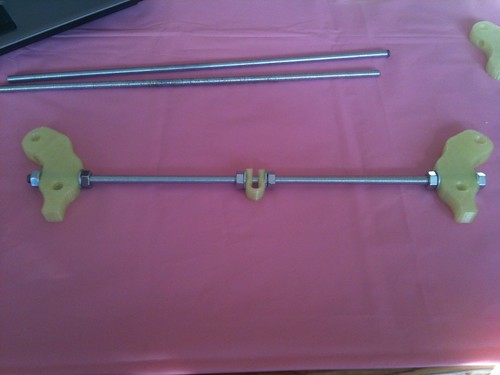
The end triangular structure soon took shape
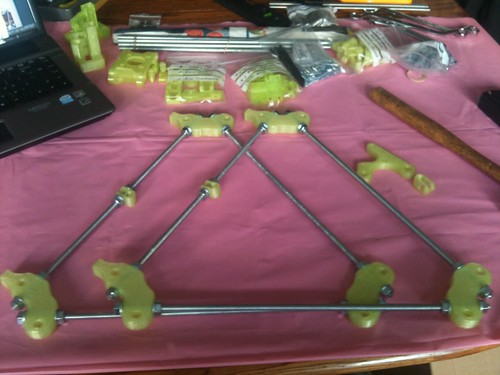
Bearings and motor holders attached to cross beams, washers all over the place
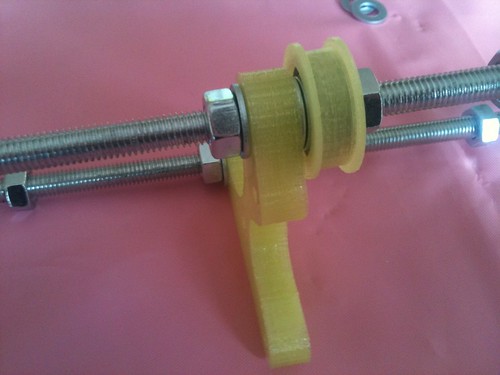
Next the frame started to take its tentative steps to standing upright.
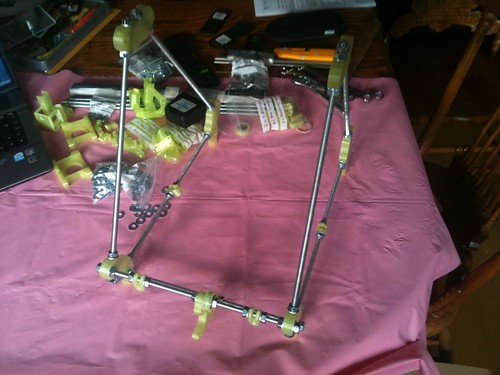
By this stage I realised (and was also being told by the instructions) that getting the measurements correct and squaring off the frame was very important.

It is around this time my software mind thinks… we can get the basics going and revisit performance and tweak it later, but instead an engineering mind thought, for once, no! get the tools measure it properly with verniers callipers and make this thing work as close as possible, and keep revisiting this as bits are added.
(There are two types of good software developer. The precise engineer who builds exactly to spec, very much needed skill and the other sort that builds for flexibility, using the spec as a guideline. Both skills complement one another and you have to know when to do each. I am not suggesting software is a giant bodge, though in many case it may well be)
Having got the frame it was then very exciting to put on the plywood moving platform which has tube bearings. It is here that using tool to make it as accurate as possible (i.e. not a quick look with a tape measure) seems to have paid off. I did have to have a couple of goes and strip this bit down but now have a relatively smooth running platform.

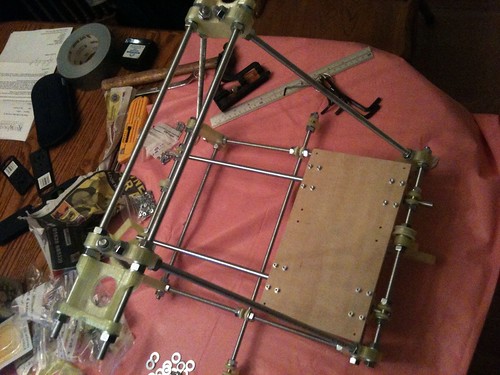
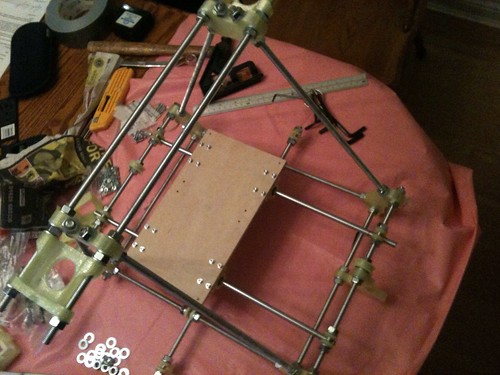
By this time I was on the specific instructions by TVRRUG as we have a slightly wider machine and some parts have been modified, which is the nature of all open source development including mechanical ones.
Last night was the final pieces of this bit of jigsaw with the vertical drive stepper motors the the rods that that lift up and down
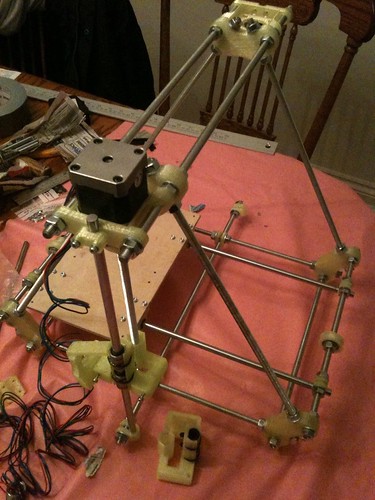
There was a tiny bit of adjustment needed again to make sure things were squared off and equal as putting the final rods for the x axis showed there was a millimetre or so of pushing needed to get the last screw in place. However I think the care in the early stages paid off. I may still have to get more accurate but it feels right, looks right and doesn’t wobble 🙂

So there is it, ready and waiting for the user groups next batch of pieces. Having built one to this stage it would make building another considerably easier.
As with all these things it is good to doing things, to be hands on and not just talk about them. Of course there is a way to go yet but I hope in the not too distant future I can start exploring some of the ways we get things to print. After all I have the haptic device, virtual worlds, minecraft etc all generating the right content.
So I will become a fully fledged fabricaneur. Making things as a business.
Whilst on the subject of 3d printing I also popped along to the Aram Gallery 110 Drury lane. A furniture shop that has a 3d printing exhibition running for a few weeks on its 3rd floor. This is called Send to Print / Print to Send
It had all sorts of examples of 3d printing. It was interesting hearing the comments of some of the other visitors as they tried to figure out the impact of all this. I tried not to dive into the conversations and enthuse at them 🙂




The full set of pictures is here
I was really pleased to see the examples of solar sintering there form the self contained desert machine by Markus Kayser

His video of this experimental art form was going down rather well earlier in the year.
The gallery was showing a number of videos including this one of the work.
They also had a fully completed reprap there, a slightly different model to mine but great to see one close up again and take the time to look at it, with a more experience eye onto its construction.

A concerned citizen of the web – SOPA? PIPA? – Blackout time
Firstly, I do not condone piracy, theft, unfair use of others work. However, I really am concerned that the gains we have made, and continue to make, in human communication online are going to be impacted by laws made in individual influential countries, like the US seeking to restrict some behaviour they regard as wrong.
There will be all sorts of political agendas at work with SOPA and PIPA in the US, but as we know country boundaries and country interests are eroded by the internet. Everything is local now. Passing laws, or attempting to that give well legally well represented organisations the power to block other “threatening” groups may seem to make sense in downloading movies, or music but the pattern does, and will apply to other areas. These laws will not stay in the areas they are intended. The vested interests of a few will have a wide reaching impact.
My personal experience in this is of the already draconian DMCA takedowns that can occur. Whilst officially working at a sports event I posted a video on youtube of the venue as part of a blog post. Somewhere one of the media partners had an intern trawling the internet for any references to the sports event and video of it. The rules being that no live play should be put on the web. In my video the venue was not even open. Yet the large company issued a DMCA takedown to google which caused the video to instantly be blocked. I did of course have the ability to try and get it back, this involved sending faxes, letters, emails etc to Youtube. It then required the other organisation to be bothered to acknowledge that. They were in the next door office, so I went and personally told them. However… the people spotting the infringements were not empowered to undo them. So it took weeks for the video to return. Now that example is just 1 simple mistake on 1 simple video but even it was a huge company with a lot of lawyers hitting one person without them. Imagine if that had led to the knock on of also crippling all my websites or my business, for however short period of time whilst an “appeal” occurred.
These control acts do nothing more than put everyone in jail cells so that no crimes are committed. It is not acceptable. Again I point out that this video incident did not matter, it was inconsequential against outing tyrants, helping the poor, improving the lives of disadvantaged people. Yet it was also not actually breaking any laws yet the law was applied. If it can happen here it can happen to anything. It will be abused, it will be misused and we will all suffer for it.
So like many much bigger sites this site will be going dark on 18th January 2012. The irony of self censoring will of course be lost on the passionate followers of this sort of restriction. We do though have do stand up against it.
There is more here in this video on what this is all about.
PROTECT IP / SOPA Breaks The Internet from Fight for the Future on Vimeo.
Car advertising the virtual way – Hyundai Veloster
Way back in the early days of the web I worked on, amongst other things, the Vauxhall car website. This was on an off for several years (we worked on multiple accounts in the early days). This was around 1997, a time when many of the things we wanted to do were not technically possible, or the web had not quite got where it needed to go. It was also at a time of CD-ROM experiences on magazines as opposed to downloads.You can see the sort of things that team was being done in 1996 here there were a number of advanced applications, traffic reports, screen savers and a touring car site, links to videos, later there were 360 quick times of the cars. It evolved in the next few years, around 98/99 into a personalised web site with login and buying capabilities and car configurations. These sorts of sites are common place now and so it is expected to be able to look at things online. Something we had all wanted to do was put the cars in a virtual experience, or game so you could drive them. At the time there were games like TOCA for touring cars so we could drive Vectra’s around, in the same livery as the touring car mini site we used. There was of course no link between the game, us and the car manufacturer, nor really the ability to make that happen. After all it was only a game, or only a website 😉
Now though the whorl has changed and this is a prime example. As a free download in the excellent Xbox driving experience Forza4 Hyundai has released a drivable, and explorable version of its new car the Veloster, both in road and race versions.
So this is really state of the art advertising. The car models are well known for their accuracy and quality in Forza. The ability to drive and experience the car inside and out, yet delivered for free makes this a very interesting experience. It doesn’t require the car manufacture to be a games developer, the game is a channel. Many people with Forza, probably everyone will at least download it as its free, new cars in game are exciting. Game challenges will pop up that are car specific too. Photos, videos etc will be created and distributed by fans online.
The physical and virtual world start to blend even more. It’s gaming but not gaming at the same time.
The future of tech education – ICT upgrades to open source
In the final show of Cool Stuff Collective series 3 I put forward my wish for 2012, which actually occurs at 20:12 in the show that ICT in schools needed a revamp (there a few days left before this rotates from the player, I don’t have the rights to youtube it AFIAK yet). Now I am not the first person to say this about ICT, and I was adding to the many voices both of the various tech industries, reports to government UPDATE* The Royal Society have just release a report too here* and those teachers bypassing some of the ICT curriculum to get kids actually skilled in computer science and building with technology. Yesterday the government minister for education Michael Gove gave a public speech at the BETT education conference that indicated that all the pressure was working. Admitting that ICT was not working, was boring the kids and was leading to a crippling loss of hi tech skills in the UK.
There is a full transcript of what was said here and of course it features general political sound bites. yet the core of it is positive as far as I can see.
Two things stood out for me.
1.”That’s why, rather than focusing on hardware or procurement, we are investing in training individuals. We need to improve the training of teachers so that they have the skills and knowledge they need to make the most of the opportunities ahead.”
2. “An open-source curriculum
Advances in technology should also make us think about the broader school curriculum in a new way.
In an open-source world, why should we accept that a curriculum is a single, static document? A statement of priorities frozen in time; a blunt instrument landing with a thunk on teachers’ desks and updated only centrally and only infrequently?
In ICT, for example, schools are already leading the way when it comes to using educational technology in new and exciting ways – and they’re doing it in spite of the existing ICT curriculum, not because of it.
The essential requirements of the National Curriculum need to be specified in law, but perhaps we could use technology creatively to help us develop that content. And beyond the new, slimmed down National Curriculum, we need to consider how we can take a wiki, collaborative approach to developing new curriculum materials; using technological platforms to their full advantage in creating something far more sophisticated than anything previously available.”
1. Is about people, teaching teachers, industry getting involved to help and
2. is an amazing alteration in the view that the processes and interactions are open source as much as the actual technology itself. Something many of us in the emerging tech and open source world already know and share.
It could be seen as dropping responsibility for ICT but I think this will work out, as most collaborative ventures as activists with clear positive ideas making changes and that will naturally drag everyone along.
As you know I try and not just talk about things but do take a bite out of technology so you don’t have too and this has all coincided with some observations and activities by my kids, aka the predlets. Predlet 1.0 is 8, Predlet 2.0 is 5 (just about). Yesterday Predlet 1.0 was not well in the morning so ended up not going to school. Rather than veg out in front of the TV I put minecraft on for her. Yes a game, but also with some other properties.
With a few hours of focus she got to do things other than just build blocks. She tried survival/crafting mode for a while and learned how hard it was to manage resources, this made her appreciate the open world of creative mode where all the blocks and resources are available to you all the more. Having switched to creative mode she started to explore the functioning blocks. Minecraft has mechanical and electrical components in it. Very soon there were switches and pressure plates opening and closing doors, mine carts propelled by red ore repeaters on rails, some needing more power to go up hill etc.
When Predlet 2.0 came home from school he was keen to join in so it was time to get computers running and a local minecraft server. This then meant the two of them were in their own virtual world, together. Where the actions of one impacted the other. They talked about it a lot and started to build a house. This was a collaborative build in a location they felt was best for the house. By a river near some mountains with a lush forest around it. 1.0 the showed 2.0 how the switches and mechanisms worked on doors.
This is the result. Viewed from my minecraft as I too can attach to our server and see how things are getting on.
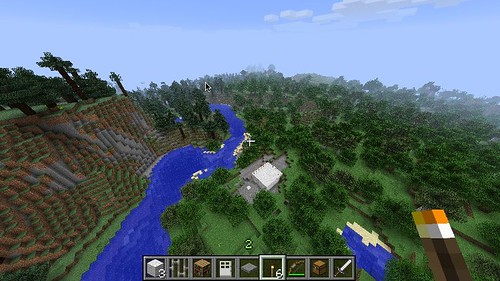
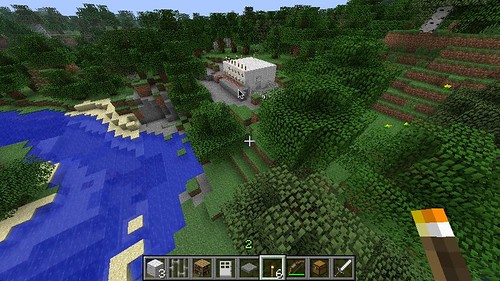
Here there is a pressure plate in front of and behind the door to “automate it”
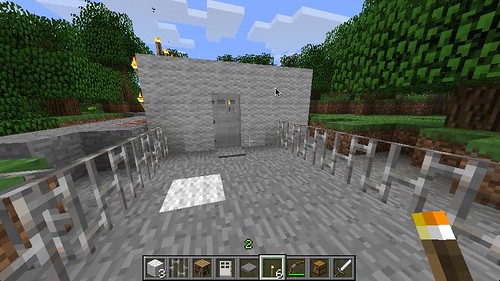
The small room has a bed each and also notice a bookcase as books are important

Whilst running this multiplayer setup across our network there was a crash. I was on a call so tech support was closed for 30 mins. They used their initiative and got the server going again, though were foiled by passwords on the clients, so instead switched to offline play on their own individual worlds until I was free.
Now this may not be a regular lesson, I am not a teacher. Yet this covered an awful lot of ground.
a)In world they were moving around in 3d space, aware of one another. There were creating and removing 3d block objects, choosing from inventories. So the mechanics of a metaverse, just like being in Second Life or OpenSim were in full use.
b)They were collaborating on a single project, dividing the tasks up, one did the walls whilst the other did the floor.
c)They chose a location near water and other resources, which to all intents and purposes is a geography lesson!
d)They shared how to start to build machinery, basic physics and mechanics and to some degree electronics, and implemented those together.
e)When there was a tech failure they attempted to resolve it, understood there was a server component that was brokering the 2 clients. When that did not work they worked out a fall back resolution. They now also are starting to ask about general systems management and how interconnected processes need to be kept running.
f)They enjoyed it immensely.
For me seeing a multiplay sandbox creative environment like this running is yet more of the same that we had with Second Life back in 2006 when we started to use the environment to communicate and share ideas. Back then we wanted our own servers for privacy and control. That spun out into things like Opensim which exists today. The pattern is the same with minecraft though it has more of a game feel and reason for existing, yet this creative mode becomes about building. Why build? well answers a) to f) above should be a good reason.
We are obviously a tech g33k family, and social exclusion from technology does worry me. However… put this sort of thing in schools to get kids interested in the first place? Those that like sys admin will gravitate towards the power of running servers. Those with a design eye will build interesting things, the engineers will make machines and understand cause and effect. Then of course there is the growth of 3d printing, the digital things can also become real products. Online social skills and etiquette will grow. It does not have to be minecraft, there are lots of ways to do this. It does not even have to be a specific tailored experience.
These things are there, available, not science fiction. There are also those of us out here ready to help because we have tried some things out. So the future looks bright doesn’t it?
Cory Doctorow warns DRM is just a mini boss to defeat
It should be no surprise that Cory Doctorow has thought this all through but in his recent presentation at 28c3 he talked about The Coming War on General Computation – The copyright war was just the beginning. What was interesting is that it was based on extrapolating the current war on copy protection, DRM and the film and music industry attempting to control how and what we see and hear based on the use of copyright. I is speech he points out that this is almost an minute replica of what is going to happen to the whole of society that far out weighs anything as insignificant as whether a song is copied or not.
There is a transcribed version here too
The premise is that of control. Those wanting to control how or what you do with something versus you wishing to use it how you want. He points out that appliances are often restricted computers. The computer can do everything, but it is not allowed to by root kits or other mechanisms that stop that particular computer doing what it could do.
You could view this as a simple case of buying the thing you want to do the thing you want. Processes that you do not want to be running on your appliance are outside your control, for your own good. Which of course may mean its just easier to use, or that you are being manipulated either financially at first or politically as a regime seeks to stop you doing things it considers detrimental to its existence.
So it seems we trade freedom for convenience. At some point that could come back to remove any freedom to trade?
The current arguments over SOPA are another escalation in the copyright wars. The internet is being looked at as something that needs filters and controls by those who need to filter and control. In doing that it breaks the internet. It threatens open source development (which of course has always threatened large corporate entities), it threatens creative expression (which of course can point fingers, be satirical and root out hypocrisy) the list goes on. Yet is it there to stop a few people stealing some things that maybe are not worth being stolen?
That is not to say there is not a problem with real thrift and real criminality that happens to occur on the internet and computers in general, but…. do we lock up everyone in jail so no-one commits any crimes?
There was a particularly good tale of unintended consequences, which is really what happens with all this sort of regulation and control, it may be well meaning to start with but messes things up.
From the transcript https://github.com/jwise/28c3-doctorow/blob/master/transcript.md (CC-BY Joshua Wise)
[[931.2]] This kind of superficial resemblance and underlying divergence happens in other engineering contexts. I’ve a friend who was once a senior executive at a big consumer packaged goods company who told me about what happened when the marketing department told the engineers that they’d thought up a great idea for detergent: from now on, they were going to make detergent that made your clothes newer every time you washed them! Well after the engineers had tried unsuccessfully to convey the concept of “entropy” to the marketing department [audience laughs], they arrived at another solution — “solution” — they’d develop a detergent that used enzymes that attacked loose fiber ends, the kind that you get with broken fibers that make your clothes look old. So every time you washed your clothes in the detergent, they would look newer. But that was because the detergent was literally digesting your clothes! Using it would literally cause your clothes to dissolve in the washing machine! This was the opposite of making clothes newer; instead, you were artificially aging your clothes every time you washed them, and as the user, the more you deployed the “solution”, the more drastic your measures had to be to keep your clothes up to date — you actually had to go buy new clothes because the old ones fell apart.
It was also this piece about hearing aids that struck a chord (again CC-BY Joshua Wise)
[[1627.8]] As a member of the Walkman generation, I have made peace with the fact that I will require a hearing aid long before I die, and of course, it won’t be a hearing aid, it will be a computer I put in my body. So when I get into a car — a computer I put my body into — with my hearing aid — a computer I put inside my body — I want to know that these technologies are not designed to keep secrets from me, and to prevent me from terminating processes on them that work against my interests. [vigorous applause from audience] Thank you.
This was because a family member recently went to have a hearing exam and in that the doctor “upgraded” the existing hearing aid to work on the audio loop facility that you have in banks and cinemas. It seemed strange that this feature, which already existed, had not been enabled by default? It makes you wonder what else is in that device or any other?
So next time you have a copyright argument, as Cory says, think of this a the mini boss towards the end of the level that we get to practice on before the mega boss at the end.
